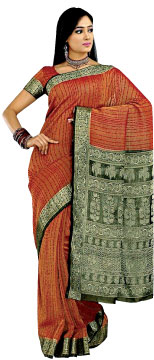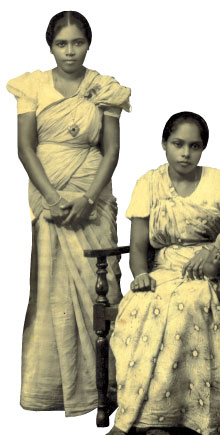Life wrapped in six yards
by Janani Amarasekera
No matter how you spell it, sari
or Ssaree, still dominates the choice of dresses for Sri Lankan women.
Whether she is a Sinhalese, a Tamil, a Muslim, or a Burgher, for a
formal event she will wear a sari. A sari is an unstitched cloth about
six yards in length. According to Buddhist and Jain literature, the word
‘sari’ is an evolution from the Prakrit word ‘Sattika’.
  Some of the ancient Tamil poetry such as Silappadhikaram and
Kadambari by Banabhatta describes women in Indian saris. Robert Knox in
his book ‘An Historical Relation of Ceylon’ (1681), describes women who
wore saris during the King’s Era, “Govi women were distinguished by the
wearing of their cloth which they wore to their heels, one end of which
cloth the women fling over their shoulders, and with the very end
carelessly cover their breasts.” Some of the ancient Tamil poetry such as Silappadhikaram and
Kadambari by Banabhatta describes women in Indian saris. Robert Knox in
his book ‘An Historical Relation of Ceylon’ (1681), describes women who
wore saris during the King’s Era, “Govi women were distinguished by the
wearing of their cloth which they wore to their heels, one end of which
cloth the women fling over their shoulders, and with the very end
carelessly cover their breasts.”
The sari is popular in many other Asian countries too such as India,
Pakistan, Nepal, Bangladesh, and Bhutan. Nowadays, women wear saris in a
range of different styles, which have evolved from the original style
due to various influences from diverse cultures. In Sri Lanka, the two
popular ways of draping the sari is the Indian style and the Kandyan
style.
The Kandyan style, which is also known as ‘osariya’, is mostly
popular in the hill country region of Kandy. The traditional Kandyan
consists of a full blouse, which covers the midriff completely, and is
partially tucked in at the front. However, modern intermingling of
styles has led to most wearers baring the midriff. The final tail of the
sari is neatly pleated rather than free flowing.
This is rather similar to the pleated decoration used in the Indian
style. Though local preferences play a role, most women decide on style
depending on personal preference or what is perceived to be most
suitable for their figure. There are even the ‘made-up osariyas’ where
one can just fit and fold the pieces together with minimum hassle.
My first encounter with a sari is seeing my mother, who is a
schoolteacher, wearing saris to school. When I was a child, most of the
days my first sight in the morning was, her draping a sari. Not only had
my mother, also my grandmother, who was employed at the Education
department wore a Kandyan to work. Both of them were experts in wearing
their own style of sari. I grew up in an environment where all the
ladies close to my heart wore saris very often. The rainbow colours of
saris have always fascinated me. So, just as most little girls, I also
was used to wear Amma’s saris when no one was at home, which has been a
secret to everybody to date.
My first very own experience of wearing a sari was when one of our
family friends decided that I was good enough to be her bridesmaid when
I was 14. After graduating, I was appointed as a teacher. My mother, who
owns the biggest collection of saris out of all the people I know,
agreed to lend me some of her saris. Therefore, the trouble I had to
undergo in preparing saris to wear was a minimum.
  For me, a teacher is someone who wears a sari. Despite that belief,
my appointment as a primary teacher in an international school did not
require me to wear saris to school. Still, I wanted to wear, which I did
for the first few weeks and gave up due to a mixture of personal
reasons. For me, a teacher is someone who wears a sari. Despite that belief,
my appointment as a primary teacher in an international school did not
require me to wear saris to school. Still, I wanted to wear, which I did
for the first few weeks and gave up due to a mixture of personal
reasons.
Time passed by, when one fine day again I decided to wear saris. With
that decision, many things around me changed; mostly the attitudes of
people. Whatever we say, people still have an admiration on women who
wear saris. The number of men, who used to mutter various things to my
ear when I am on the road, was decreased in a notable number. In
offices, I got preference among others, and people went out of their way
to get things done for me, something that never happened in those same
places when I was in trousers.
Many women choose other casual dresses over the sari because of the
convenience. But the sari still continues to maintain its charm among
women. They are becoming so captivating day by day that it is hard to
eschew from them. For many traditional women saris are their one of the
most prized possessions. They have become a staple attire of women’s
wardrobe.
But, for many women with busy lifestyles, running around with a sari
is no easy task. However, a sari brings out the curves and lines of a
woman that fascinates the people around us. A sari can make anybody look
gorgeous. Whatever is your size or height, the sari is there to make any
woman more feminine.
People might say, ‘We are modern thinkers’ but from the bottom of
their hearts they still like the woman who is wrapped in six yards. |

